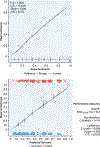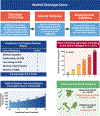Clinical Risk Score to Predict Pathogenic Genotypes in Patients With Dilated Cardiomyopathy
- PMID: 36109106
- PMCID: PMC10804447
- DOI: 10.1016/j.jacc.2022.06.040
Clinical Risk Score to Predict Pathogenic Genotypes in Patients With Dilated Cardiomyopathy
Abstract
Background: Although genotyping allows family screening and influences risk-stratification in patients with nonischemic dilated cardiomyopathy (DCM) or isolated left ventricular systolic dysfunction (LVSD), its result is negative in a significant number of patients, limiting its widespread adoption.
Objectives: This study sought to develop and externally validate a score that predicts the probability for a positive genetic test result (G+) in DCM/LVSD.
Methods: Clinical, electrocardiogram, and echocardiographic variables were collected in 1,015 genotyped patients from Spain with DCM/LVSD. Multivariable logistic regression analysis was used to identify variables independently predicting G+, which were summed to create the Madrid Genotype Score. The external validation sample comprised 1,097 genotyped patients from the Maastricht and Trieste registries.
Results: A G+ result was found in 377 (37%) and 289 (26%) patients from the derivation and validation cohorts, respectively. Independent predictors of a G+ result in the derivation cohort were: family history of DCM (OR: 2.29; 95% CI: 1.73-3.04; P < 0.001), low electrocardiogram voltage in peripheral leads (OR: 3.61; 95% CI: 2.38-5.49; P < 0.001), skeletal myopathy (OR: 3.42; 95% CI: 1.60-7.31; P = 0.001), absence of hypertension (OR: 2.28; 95% CI: 1.67-3.13; P < 0.001), and absence of left bundle branch block (OR: 3.58; 95% CI: 2.57-5.01; P < 0.001). A score containing these factors predicted a G+ result, ranging from 3% when all predictors were absent to 79% when ≥4 predictors were present. Internal validation provided a C-statistic of 0.74 (95% CI: 0.71-0.77) and a calibration slope of 0.94 (95% CI: 0.80-1.10). The C-statistic in the external validation cohort was 0.74 (95% CI: 0.71-0.78).
Conclusions: The Madrid Genotype Score is an accurate tool to predict a G+ result in DCM/LVSD.
Keywords: dilated cardiomyopathy; genetic variant; genetics; genotype; predictor.
Copyright © 2022 The Authors. Published by Elsevier Inc. All rights reserved.
Conflict of interest statement
Funding Support and Author Disclosures This work was supported by grants from the Instituto de Salud Carlos III (ISCIII) (PI17/01941, PI18/0004, PI19/01283, PI20/0320) (co-funded by European Regional Development Fund/European Social Fund "A way to make Europe"/"Investing in your future"). The CNIC is supported by the ISCIII, MCIN, the Pro-CNIC Foundation, and the Severo Ochoa Centers of Excellence program (CEX2020-001041-S). This study was also supported by the Netherlands Cardiovascular Research Initiative, an initiative with support from the Dutch Heart Foundation, DCVA Double Dosis 2020B005. The Hospital Universitario Puerta de Hierro, the Hospital Universitario Virgen de la Arrixaca and the Azienda Sanitaria Universitaria Giuliano-Isontina are members of the European Reference Network for rare, low-prevalence, and complex diseases of the heart (ERN GUARD-Heart). Dr Ochoa is an employee of Health in Code. All other authors have reported that they have no relationships relevant to the contents of this paper to disclose.
Figures



Comment in
-
Genetic Testing for Dilated Cardiomyopathy: Old School Is New School.J Am Coll Cardiol. 2022 Sep 20;80(12):1127-1129. doi: 10.1016/j.jacc.2022.07.010. J Am Coll Cardiol. 2022. PMID: 36109107 No abstract available.
References
-
- Pinto YM, Elliott PM, Arbustini E, et al. Proposal for a revised definition of dilated cardiomyopathy, hypokinetic non-dilated cardiomyopathy, and its implications for clinical practice: a position statement of the ESC Working Group on Myocardial and Pericardial Diseases. Eur Heart J. 2016;37: 1850–1858. 10.1093/eurheartj/ehv727 - DOI - PubMed

